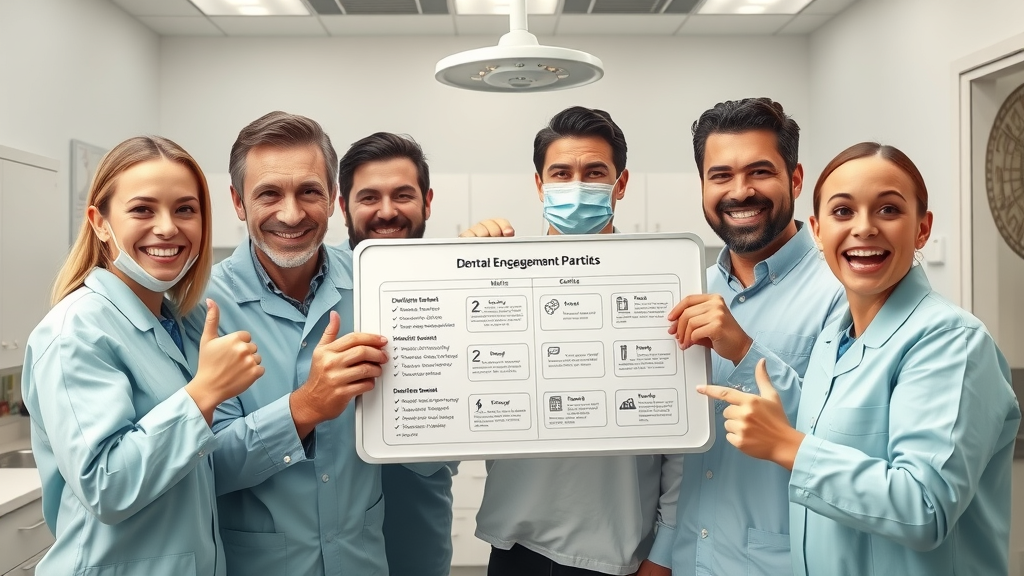Did you know that dental patients who actively participate in their oral health journey are twice as likely to follow their treatment plans and report significantly higher satisfaction? Patient engagement in dental care isn’t just a modern buzzword—it’s a revolution poised to reshape how dental practices deliver care and how patients experience their dental visits. In this comprehensive guide, you'll discover why engaging patients matters, how it leads to outstanding outcomes, and practical strategies any dental practice can adopt today. Read on to learn how you can transform every visit into an opportunity for healthier smiles and happier patients.
What You'll Learn
- How patient engagement is transforming the patient experience in dental care.
- Key strategies dental practices can use to enhance engagement.
- Effective communication techniques for building trust and loyalty.
- Technological innovations driving better dental health outcomes.
- Proven methods to measure and sustain long-term patient engagement.
Why Patient Engagement in Dental Care Is Revolutionizing the Patient Experience
Patient engagement in dental care is rapidly becoming the gold standard for modern dental practices. A truly engaged dental patient doesn’t just show up for appointments—they actively partner with their dental care provider , understand their treatment plan, and make informed decisions about their oral health. Research shows that this level of involvement not only supports better health outcomes but also ensures that patients feel respected, valued, and satisfied with their care.
By transforming traditional dental care into a collaborative experience, dental practices can go beyond routine cleanings and procedures. They can empower patients to take ownership of their dental health, resulting in long-term loyalty and improved dental health outcomes. This shift boosts patient satisfaction, making dental visits less intimidating and more rewarding, both for the patient and the dental professionals delivering care.

The Surprising Statistics Behind Patient Engagement in Dental Care
Studies have consistently shown that dental patients who are engaged in their oral health journey experience more positive outcomes than those who are not. According to the latest research, dental patients who are involved in their care are:
- Twice as likely to adhere to their treatment plans, which results in a notable decrease in oral health issues such as cavities or gum disease.
- 51% more likely to report high satisfaction scores following dental procedures, including both routine and specialized treatments.
- 35% less likely to miss follow-up appointments, which plays a critical role in maintaining optimum dental health.
"Research shows that highly engaged dental patients are twice as likely to adhere to their treatment plan, resulting in a significant boost in patient satisfaction and improved oral health outcomes."
Exploring the Core of Patient Engagement in Dental Care
What Defines Patient Engagement in Dental Care?
Patient engagement in dental care is a proactive partnership between the dental professional and the dental patient. This partnership is built on three fundamental pillars: education , motivation , and two-way communication . When dental patients are well-educated about their oral health and treatment options, they’re empowered to make informed decisions that align with their personal needs and preferences. Motivation comes from understanding the importance of each procedure and the long-term benefits of regular dental care. Finally, two-way communication ensures that patients' concerns are heard, questions are addressed, and treatment plans are co-created for optimal outcomes.
Engaged dental patients don’t passively receive instructions—they participate in the decision-making process at every step. Whether it's discussing treatment options, understanding preventive measures, or following through with aftercare instructions, an engaged patient feels involved and respected. Dental practices that recognize this dynamic benefit from improved patient experience and stronger patient-provider relationships, ultimately leading to higher satisfaction and better oral health.

Patient Engagement and Patient Satisfaction: Direct Connections
There is a clear and direct relationship between patient engagement and patient satisfaction in dental care. Patients who are engaged throughout their oral health journey consistently report a more positive overall patient experience. Actively participating in decision-making and treatment planning allows dental patients to feel a sense of control and partnership with their dental care provider.
This active involvement also leads to improved health care outcomes and loyalty toward the dental practice. When patients perceive that their opinions, preferences, and well-being are top priorities, trust is built, and satisfaction levels soar. Engaged patients are not only more likely to complete their dental procedures as scheduled but are also more likely to recommend the practice to friends and family—fueling long-term growth for the dental office and better oral health for the community.
How Dental Practices Can Foster Better Patient Engagement in Dental Care
Engagement Strategies for Modern Dental Practices
Today’s leading dental practices are embracing innovative engagement strategies to enhance patient involvement and satisfaction. Implementing digital tools such as patient portals allows dental patients to easily access their health records and treatment plans, empowering informed decision-making and communication outside of traditional office hours. Interactive oral health apps further strengthen this bond by providing educational resources, reminders, and direct messaging with the dental care team.
Effective patient engagement in dental care also involves proactively reaching out with appointment reminders, personalized wellness advice, and follow-up communications post-procedure. These touchpoints make patients feel valued and supported, helping them stay on track with preventive care and ongoing treatment. By investing in multifaceted engagement strategies, dental practices can boost both health outcomes and the overall patient experience.
The Role of Effective Communication in Dental Patient Engagement
Effective communication stands at the heart of successful patient engagement and is essential for building trust between dental professionals and their patients. Active listening ensures that patients’ concerns and anxieties are understood, and open dialogue encourages honest discussions about treatment options and personal preferences.
Continuous feedback is key—patients appreciate it when they know their input leads to tangible changes in their care experience. By making communication a priority, dental practices can enhance patient loyalty, improve patient engagement, and foster long-term relationships built on trust and respect.
"Effective communication is the cornerstone to improving patient engagement in dental care, which drives loyalty and trust."

Designing Personalized Care to Enhance Patient Engagement in Dental Care

Personalized Care Approaches for Dental Patients
Practicing personalized care is one of the most effective ways to enhance patient engagement in dental care. Customized treatment plans ensure that patients’ unique oral health needs, lifestyle, and goals are considered at every step. This approach not only improves health outcomes but also increases the likelihood that patients will follow through with the recommended dental procedures.
Incorporating cultural sensitivity and technology-enabled solutions—such as digital dental plans, teleconsultations, and interactive educational modules—enables dental practices to meet the diverse needs of their patient base. By continuing to tailor care and communication, dental professionals demonstrate commitment to patient well-being and foster a sense of trust that motivates patients to participate actively in their dental health journey.
Building Trust and Rapport Throughout the Dental Patient Journey
Trust is the cornerstone of any strong patient-provider relationship. Employing empathy and transparency within dental care not only creates a safe and supportive environment but also ensures that patients feel understood and respected throughout every interaction. Being open about treatment options, expected outcomes, and potential challenges empowers dental patients to make informed decisions and participate fully in their care.
Transparency in communication and a commitment to honesty, even about difficult topics or potential complications, helps build rapport and encourages ongoing patient engagement. Ultimately, when patients perceive their providers as trustworthy and genuinely invested in their oral health, satisfaction and loyalty reach new heights—fueling the success of the dental practice.
Overcoming Barriers to Effective Patient Engagement in Dental Care
Common Obstacles Dental Patients and Practices Face
Despite the many benefits of patient engagement, dental offices often encounter notable obstacles. Time constraints mean dental professionals may struggle to allocate enough time for thorough explanations and meaningful conversations during short appointments. Technology gaps arise when patients or staff lack familiarity with digital tools integral to modern engagement strategies.
Furthermore, differences in health literacy can prevent patients from fully understanding their treatment options or oral health instructions, leading to reluctance and resistance to change established habits. Recognizing and addressing these challenges is the first step toward building a culture of engagement that benefits both providers and patients in dental care.

Overcoming Barriers with Proactive Engagement Strategies
Dental practices can overcome these barriers with proactive engagement strategies . Providing clear and accessible educational materials helps bridge gaps in health literacy, ensuring that every dental patient can make informed decisions about their care. Regular staff training on communication and cultural competency enables dental teams to better serve diverse patient populations.
Outreach programs, both within the dental office and in the community, foster trust and encourage continued participation in dental care. By dedicating time and resources to ongoing education and open communication, dental practices can create an environment where patient engagement flourishes and health outcomes improve.
Top Patient Engagement Strategies to Improve Patient Experience in Dental Care
- Automated appointment reminders and check-ins – using SMS/email to prompt patients and reduce no-shows.
- Dedicated follow-up calls – ensuring post-procedure support and clarifying aftercare instructions.
- Personalized wellness initiatives – such as oral health challenges, newsletters, or educational campaigns tailored to individual patient needs.
- Implementing patient portals and mobile apps – offering real-time access to records, treatment plans, and communication with dental staff.
- Interactive patient feedback surveys – gathering insights for ongoing practice improvement and enhanced patient experience.

| Engagement Strategy | Effectiveness in Boosting Patient Satisfaction | Example in Dental Care |
|---|---|---|
| Automated Reminders | High – reduces missed appointments, improves follow-through | Scheduled SMS reminders before hygiene visits |
| Patient Portals | Very High – empowers patients, facilitates communication | Online access to treatment plans and records |
| Follow-Up Calls | Medium – reinforces instructions, personalizes care | Checking in after a major dental procedure |
| Wellness Initiatives | Medium – creates long-term engagement and education | Email campaigns for preventive care tips |
| Patient Feedback Surveys | High – identifies issues, shows patient input is valued | Post-visit satisfaction surveys emailed to patients |
Embracing Technology: Digital Tools Transforming Patient Engagement in Dental Care
The digital era has unlocked new heights for patient engagement in dental care. By leveraging technology, dental practices can streamline administrative tasks, offer real-time updates, and deliver an unmatched patient experience. These digital advances empower patients, making dental care more accessible and interactive, while also freeing up the dental team to focus on delivering high-quality oral health care.

Patient Portals and Mobile Apps for Dental Patients
Patient portals and mobile apps have revolutionized communication in dental care. Through these tools, dental patients can schedule appointments, access treatment plans, and manage their health records anytime. Real-time messaging with dental staff enhances the patient experience, providing support and reducing anxiety ahead of dental procedures.
These platforms encourage greater involvement, supporting patients as they track oral health progress or receive customized reminders for preventive care. By integrating portals and apps into everyday operations, dental practices see improved adherence to treatment plans and a boost in patient satisfaction.
Teledentistry: Expanding Access and Improving Dental Health
Teledentistry offers a flexible channel for patient engagement in dental care . Dental patients can conduct virtual consultations, share photos of dental issues, and receive expert guidance without leaving home. This not only expands access for patients living in remote or underserved areas but also supports those with mobility challenges.
As dental practices increasingly adopt teledentistry, patients benefit from more frequent touchpoints, greater convenience, and timely follow-up, all contributing to enhanced health outcomes and an improved patient experience.
Measuring the Impact of Patient Engagement in Dental Care
Metrics That Matter for Patient Satisfaction and Dental Health Outcomes
Assessing the effectiveness of engagement strategies is crucial. Dental offices commonly track key metrics such as patient feedback scores, adherence rates for treatment plans, and clinical indicators of oral health improvement. Collecting this data provides clear insight into which areas are thriving and where further improvements are needed.
For example, increased patient satisfaction scores or a reduction in missed appointments can signal successful engagement initiatives, while shifts in oral health indicators reveal long-term progress for the dental patient population.

Continuous Improvement for Dental Practices
Ongoing success relies on continuous improvement —using patient data, reviews, and feedback loops to refine engagement strategies. By periodically reviewing what works and adjusting approaches, dental practices can evolve with changing patient needs and emerging technologies.
Incorporating this continuous feedback accelerates progress, fosters innovation, and keeps both patients and dental teams motivated toward optimal oral health outcomes.
Training Dental Teams: Elevating Patient Engagement and Communication Skills
Staff Training Programs for Enhanced Patient Experience
Comprehensive training programs are vital for preparing dental teams to deliver outstanding engagement and communication. Workshops, role-playing exercises, and continuing education help staff master the skills needed for active listening, empathy, and cultural competence.
Ongoing education ensures that all team members—from receptionists to hygienists—are equipped to support an exceptional patient experience at every touchpoint within the dental office.

Role of a Patient Engagement Specialist in Dental Care
A patient engagement specialist is becoming an invaluable asset for dental practices. Their duties involve onboarding new dental patients, improving communication between staff and patients, and tracking satisfaction metrics. By acting as a central point of contact, they ensure every patient feels informed, supported, and valued.
These specialists develop best practices, facilitate workshops, and continuously evaluate processes to ensure the highest standards of patient engagement are met. Their efforts help dental offices maintain a culture of continuous improvement, ultimately benefiting both patient outcomes and practice growth.
Case Studies: How Leading Dental Practices Excel in Patient Engagement
- Case 1: Community Dental Group – By implementing a mobile app for appointments and educational videos, the clinic saw a 29% increase in patient portal usage and a 20% reduction in missed cleanings.
- Case 2: Family Smiles Practice – Focused on staff training and quarterly feedback surveys, their patient satisfaction scores climbed to 95%, resulting in more referrals and a thriving reputation.
Best Practices for Sustaining Long-Term Patient Engagement in Dental Care
- Schedule regular check-ins using patient-preferred methods (calls, texts, emails).
- Maintain updated digital content and educational resources.
- Encourage ongoing staff training and feedback sessions.
- Leverage community partnerships for outreach and education.
- Set clear goals and measure progress with engagement metrics.
Visual walkthrough of top patient engagement tactics for dental practices
Watch a step-by-step demonstration on integrating digital patient portals, collecting real-time feedback, and building a practice culture centered around patient involvement and oral health improvement.
People Also Ask
What are the 5 stages of patient engagement framework?
- Awareness: The patient recognizes their need for dental care (e.g., realizes they have bleeding gums).
- Involvement: The dental patient begins asking questions and seeking knowledge about their oral health or dental procedure.
- Engagement: Patient actively participates in discussions about treatment plans and preventive dental health practices.
- Activation: The patient commits to following recommended dental procedures and lifestyle changes.
- Empowerment: The patient independently maintains oral health and advocates for optimal care, becoming an active partner in dental care.
What is an example of patient engagement?
- A real-world example is a dental patient who uses a practice’s online portal to access educational materials, schedules hygiene appointments, asks follow-up questions via secure messaging, and provides feedback after each visit. This level of engagement leads to improved dental health, greater satisfaction, and a collaborative patient-provider relationship.
What is the patient engagement process?
- The typical process starts with the initial contact (welcoming the patient and explaining the dental practice’s approach), continues with thorough education about oral health and treatment options, co-creating a personalized treatment plan, and providing ongoing support through reminders, portals, and regular communication. Each step ensures patients feel informed, involved, and continuously supported.
What does a patient engagement specialist do?
- Within dental practices, a patient engagement specialist facilitates onboarding, helps patients navigate available resources, improves communication channels, tracks satisfaction, coordinates care plans, and ensures continual support—playing a vital role in boosting patient satisfaction and improving oral health outcomes.
Frequently Asked Questions about Patient Engagement in Dental Care
- Why is patient engagement important in dental care? Patient engagement drives better adherence to treatment plans, improves oral health outcomes, and makes patients feel respected and valued.
- How can dental practices enhance patient engagement? Use digital tools, personalized care, effective communication, and ongoing education to foster involvement.
- What benefits do dental patients see from being engaged? Engaged patients experience greater satisfaction, maintain better oral health, and develop lasting trust with their dental provider.
- Do patient engagement strategies work for all types of dental practices? Yes—engagement strategies can be tailored to fit practices of any size or specialty.
Recap: Key Insights on Patient Engagement in Dental Care for Dental Practices
- Enhanced patient engagement leads to better oral health and patient satisfaction.
- Communication, personalization, and digital tools empower patients.
- Measuring progress and continuous improvement drive dental practice growth.
- A culture of engagement transforms the entire patient experience in dental care.
Step-by-step guide to implementing an engagement model tailored to dental care
This instructional video covers every stage—from onboarding new dental patients and establishing digital touchpoints to gathering feedback and refining engagement strategies for sustainable oral health improvement.
What Readers Will Gain from Improving Patient Engagement in Dental Care
- Dental practices: Enjoy stronger loyalty, higher patient satisfaction, and measurable growth.
- Dental patients: Benefit from better health outcomes, personalized care, and a positive healthcare experience.
Emerging trends, technology innovations, and their impact on dental patient experience and oral health
Discover how artificial intelligence, predictive health analytics, and evolving patient engagement strategies will shape dental practices and revolutionize oral health for years to come.
Take the Next Steps: Transform Your Dental Practice with Engaged Patients
- Implement the strategies discussed to foster greater engagement.
- Use assessment and feedback tools to measure your progress.
- Commit to ongoing education and investment in both technology and team training to sustain success.
Start engaging your dental patients today—invest in effective communication, personalized care, and technology to achieve transformative outcomes for your dental practice and your patients’ oral health.
Enhancing patient engagement in dental care is pivotal for improving satisfaction and health outcomes. For instance, the article “Dental Patient Engagement: Boost Relationships with Top Strategies & Tools” outlines effective methods such as personalized communication, educational content, and loyalty programs to strengthen patient relationships. ( smiletactics.com ) Similarly, “Dental Patient Engagement: 7 Strategies to Improve Patient Experience” emphasizes the importance of proactive communication tools, personalized interactions, and the use of patient portals to enhance engagement. ( xcare.app ) Implementing these strategies can transform dental practices by fostering trust and loyalty among patients.
 Add Row
Add Row  Add
Add 




Write A Comment